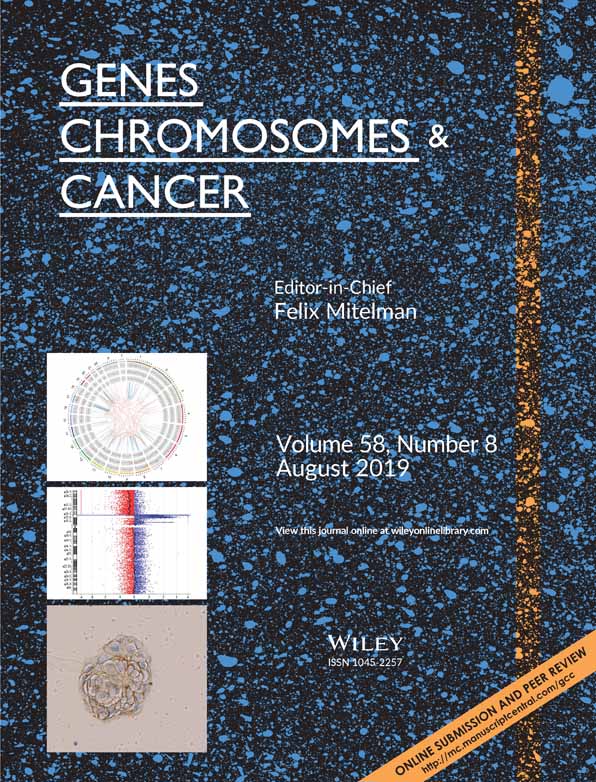Further evidence that full gene deletions of DICER1 predispose to DICER1 syndrome
Leanne de Kock
Department of Human Genetics, McGill University, Montréal, Québec, Canada
Lady Davis Institute, Segal Cancer Centre, Jewish General Hospital, Montréal, Québec, Canada
Search for more papers by this authorMorten Hillmer
Institute of Human Genetics, Ulm University and Ulm University Medical Centre, Ulm, Germany
Search for more papers by this authorRabea Wagener
Institute of Human Genetics, Ulm University and Ulm University Medical Centre, Ulm, Germany
Search for more papers by this authorDorothée Bouron-Dal Soglio
Department of Pathology, CHU Sainte Justine, Montréal, Québec, Canada
Department of Pathology and Cellular Biology, Faculty of Medicine, Université de Montréal, Montréal, Québec, Canada
Search for more papers by this authorNelly Sabbaghian
Lady Davis Institute, Segal Cancer Centre, Jewish General Hospital, Montréal, Québec, Canada
Search for more papers by this authorReiner Siebert
Institute of Human Genetics, Ulm University and Ulm University Medical Centre, Ulm, Germany
Search for more papers by this authorMichal Miller
Department of Pediatrics, Geisinger Medical Centre, Danville, Pennsylvania
Search for more papers by this authorCorresponding Author
William D. Foulkes
Department of Human Genetics, McGill University, Montréal, Québec, Canada
Lady Davis Institute, Segal Cancer Centre, Jewish General Hospital, Montréal, Québec, Canada
Department of Medical Genetics, Research Institute of the McGill University Health Centre, Montreal, Québec, Canada
Correspondence
Dr. William D. Foulkes, Department of Medical Genetics, Lady Davis Institute, Segal Cancer Centre, Jewish General Hospital, 3755 Cote-Sainte-Catherine Road, Montreal, Quebec, H3T 1E2, Canada.
Email: [email protected]
Search for more papers by this authorLeanne de Kock
Department of Human Genetics, McGill University, Montréal, Québec, Canada
Lady Davis Institute, Segal Cancer Centre, Jewish General Hospital, Montréal, Québec, Canada
Search for more papers by this authorMorten Hillmer
Institute of Human Genetics, Ulm University and Ulm University Medical Centre, Ulm, Germany
Search for more papers by this authorRabea Wagener
Institute of Human Genetics, Ulm University and Ulm University Medical Centre, Ulm, Germany
Search for more papers by this authorDorothée Bouron-Dal Soglio
Department of Pathology, CHU Sainte Justine, Montréal, Québec, Canada
Department of Pathology and Cellular Biology, Faculty of Medicine, Université de Montréal, Montréal, Québec, Canada
Search for more papers by this authorNelly Sabbaghian
Lady Davis Institute, Segal Cancer Centre, Jewish General Hospital, Montréal, Québec, Canada
Search for more papers by this authorReiner Siebert
Institute of Human Genetics, Ulm University and Ulm University Medical Centre, Ulm, Germany
Search for more papers by this authorMichal Miller
Department of Pediatrics, Geisinger Medical Centre, Danville, Pennsylvania
Search for more papers by this authorCorresponding Author
William D. Foulkes
Department of Human Genetics, McGill University, Montréal, Québec, Canada
Lady Davis Institute, Segal Cancer Centre, Jewish General Hospital, Montréal, Québec, Canada
Department of Medical Genetics, Research Institute of the McGill University Health Centre, Montreal, Québec, Canada
Correspondence
Dr. William D. Foulkes, Department of Medical Genetics, Lady Davis Institute, Segal Cancer Centre, Jewish General Hospital, 3755 Cote-Sainte-Catherine Road, Montreal, Quebec, H3T 1E2, Canada.
Email: [email protected]
Search for more papers by this authorFunding information: Canadian Institute of Health Research Foundation grant to WDF, Grant/Award Number: FDN-148390; DKG World Fellowship to LdK; Infrastructural support from the KinderKrebsInitiative Buchholz/Holm-Seppensen to RS and RW for research on pediatric cancers
Supporting Information
| Filename | Description |
|---|---|
| GCC22728-sup-0001-supinfo.docxWord 2007 document , 5.7 MB | Appendix S1: Supporting information |
Please note: The publisher is not responsible for the content or functionality of any supporting information supplied by the authors. Any queries (other than missing content) should be directed to the corresponding author for the article.
REFERNECES
- 1Foulkes WD, Priest JR, Duchaine TF. DICER1: mutations, microRNAs and mechanisms. Nat Rev Cancer. 2014; 14: 662-672.
- 2de Kock L, Geoffrion D, Rivera B, et al. Multiple DICER1-related tumors in a child with a large interstitial 14q32 deletion. Genes Chromosomes Cancer. 2018; 57: 223-230.
- 3Herriges JC, Brown S, Longhurst M, et al. Identification of two 14q32 deletions involving DICER1 associated with the development of DICER1-related tumors. Eur J Med Genet. 2019; 62: 9-14.
- 4van Engelen K, Villani A, Wasserman JD, et al. DICER1 syndrome: approach to testing and management at a large pediatric tertiary care center. Pediatr Blood Cancer. 2018; 65: e26720.
- 5Sabbaghian N, Srivastava A, Hamel N, et al. Germ-line deletion in DICER1 revealed by a novel MLPA assay using synthetic oligonucleotides. Eur J Hum Genet. 2014; 22: 564-567.
- 6de Kock L, Terzic T, McCluggage WG, et al. DICER1 mutations are consistently present in moderately and poorly differentiated Sertoli-Leydig cell tumors. Am J Surg Pathol. 2017; 41: 1178-1187.
- 7Apellaniz-Ruiz M, de Kock L, Sabbaghian N, et al. Familial multinodular goiter and Sertoli-Leydig cell tumors associated with a large intragenic in-frame DICER1 deletion. Eur J Endocrinol. 2018; 178: K11-K19.




